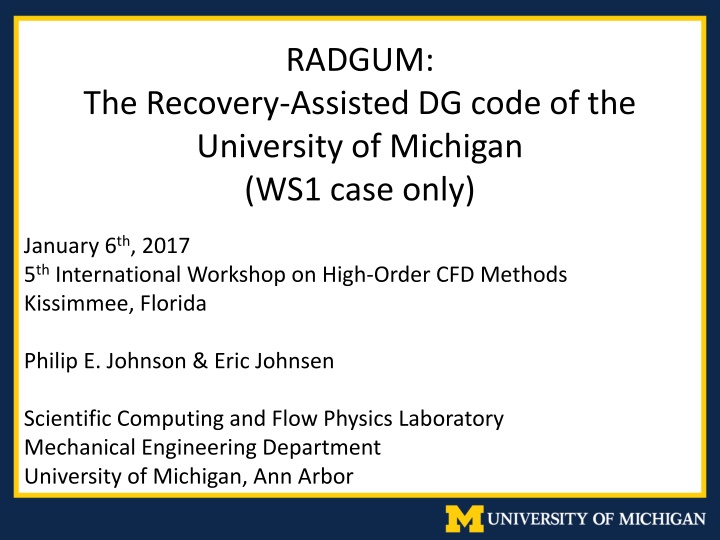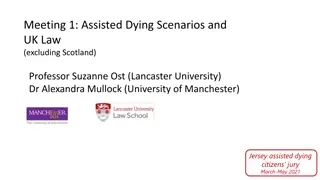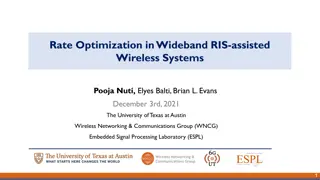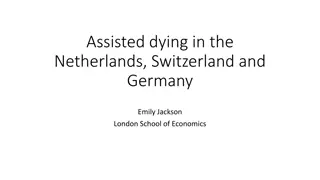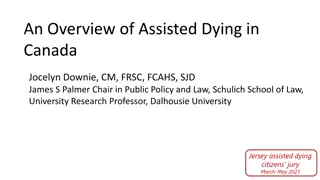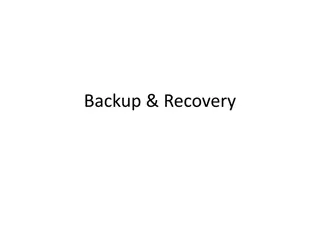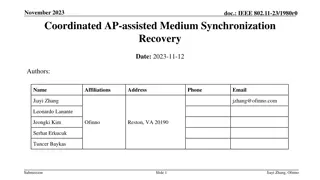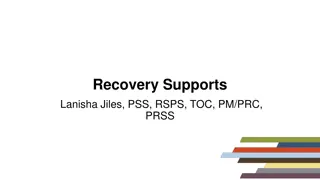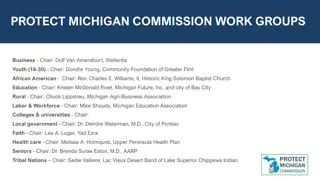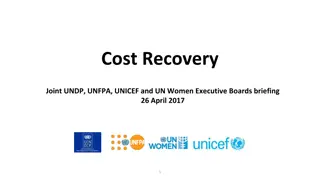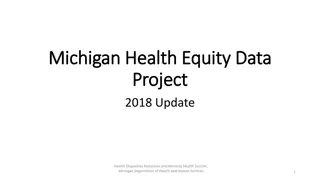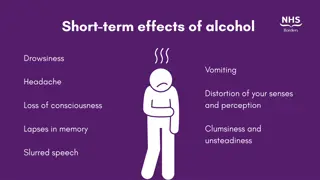Recovery-Assisted DG Code Overview at University of Michigan
Recovery-Assisted DG code of the University of Michigan presented at the 5th International Workshop on High-Order CFD Methods. The code features spatial discretization using Discontinuous Galerkin, nodal basis, explicit Runge-Kutta time integration, and other non-standard features such as ICB reconstruction, Compact Gradient Recovery (CGR), shock capturing techniques, and more. The recovery concept, demonstrations, and comparisons with conventional DG methods are also discussed.
Download Presentation

Please find below an Image/Link to download the presentation.
The content on the website is provided AS IS for your information and personal use only. It may not be sold, licensed, or shared on other websites without obtaining consent from the author.If you encounter any issues during the download, it is possible that the publisher has removed the file from their server.
You are allowed to download the files provided on this website for personal or commercial use, subject to the condition that they are used lawfully. All files are the property of their respective owners.
The content on the website is provided AS IS for your information and personal use only. It may not be sold, licensed, or shared on other websites without obtaining consent from the author.
E N D
Presentation Transcript
RADGUM: The Recovery-Assisted DG code of the University of Michigan (WS1 case only) January 6th, 2017 5th International Workshop on High-Order CFD Methods Kissimmee, Florida Philip E. Johnson & Eric Johnsen Scientific Computing and Flow Physics Laboratory Mechanical Engineering Department University of Michigan, Ann Arbor
Code Overview Basic Features: Spatial Discretization: Discontinuous Galerkin, nodal basis Time Integration: Explicit Runge-Kutta (4th order and 8th order available) Riemann solver: Roe, SLAU2 Quadrature: One quadrature point per basis function Non-Standard Features: ICB reconstruction: compact technique, adjusts Riemann solver arguments Compact Gradient Recovery (CGR): Mixes Recovery with traditional mixed formulation for viscous terms Shock Capturing: PDE-based artificial dissipation inspired by C-method of Reisner et al. Discontinuity Sensor:Detects shock/contact discontinuities, tags troubled elements Kitamura & Shima, JCP 2013 Reisner et al., JCP 2013 1
Recovery Concept ? , ? ? DG solution: ? Recovered solution: ??? Exact Distribution U A B A B A B ? = ? + ? + sin 2??? Van Leer & Nomura, AIAA Conf. 2005 2 Schematic from [Johnson & Johnsen, APS DFD 2015]
Recovery Demonstration: ? = ? Recovered solution (degree 2? + 1 = 7 polynomial) more accurate at interface ? ? 3
Recovery Demonstration: ? = ? ICB reconstructions (degree ? + 2 = 4) equal at closest quadrature points ? ? 3
Our Approach vs. Conventional DG For diffusive fluxes: CGR maintains compact stencil , offers advantages over BR2 Larger allowable explicit timestep size Improved wavenumber resolution For advection problems: DG weak form: Must calculate flux along interfaces Conventional approach (upwind DG): plug in left/right values of DG solution Conventional approach: Our approach: ICB reconstruction scheme Replace left/right solution values with ICB reconstruction: Johnson & Johnsen, AIAA Aviation 2017 4 Khieu & Johnsen, AIAA Aviation 2014
Taylor-Green Test (WS1) Code setup: p2 elements, uniform hex mesh (27 DOF/element), RK4 time integration Reference result taken from HiOCFD3 workshop Our approach allows larger stable time step ICB+CGR: 75 CPU-hours Conventional: 304 CPU-Hours ICB+CGR: 2.5 CPU-hours Conventional: 9.2 CPU-Hours 5
Energy Spectrum Computation 1) Populate velocity (?,?,?) on evenly-spaced 3D grid ? =2?? ? 2) Build discrete ? = ??,??,?? ?? ?= ?? 2+ (? +1 2); ? {0,1, ,? 2} 3) For each ?(??,?? ??):average over entire grid (all ?) for velocity correlation ???? =< ? ? + ? ?(?) > ???? =< ? ? + ? ?(?) > ???? =< ? ? + ? ?(?) > 4) Open Matlab 6
Energy Spectrum Computation 5) Build 3D Fourier transform of each correlation: ? = ????(???), ? = ????(???), ? = ???? ??? 6) Calculate energy spectrum: ? ? = 1 2( |???,??,??| + |???,??,??| + |???,??,??|) ??2+ ??2+ ??2= ? 1 ? 2?2+ ?2+ ?2?? 7) Normalize: scale ?(?) to achieve K=1 ? ? ?? = ? 7
Conclusions Were the verification cases helpful and which ones were used? TGV: First 3D simulation, demonstrates value of ICB+CGR for nonlinear problem What improvements are needed to the test case? TGV: Standardize energy spectrum calculation and make reference data more easily accessible Did the test case prompt you to improve your methods/solver Yes: added 3D capability What worked well with your method/solver? Feature resolution on Cartesian meshes (ICB very helpful) What improvements are necessary to your method/solver? ICB/CGR robustness on non-Cartesian elements 8
SciTech Talk Title: A Compact Discontinuous Galerkin Method for Advection-Diffusion Problems Session: FD-33, High-Order CFD Methods 1 Setting: Sun 2, January 10, 9:30 AM Acknowledgements Computing resources were provided by the NSF via grant 1531752 MRI: Acquisition of Conflux, A Novel Platform for Data-Driven Computational Physics (Tech. Monitor: Ed Walker). 9
References Kitamura, K. & Shima, E., Towards shock-stable and accurate hypersonic heating computations: A new pressure flux for AUSM-family schemes, Journal of Computational Physics, Vol. 245, 2013. Reisner, J., Serensca, J., Shkoller, S., A space-time smooth artificial viscosity method for nonlinear conservation laws, Journal of Computational Physics, Vol. 235, 2013. Johnson, P.E. & Johnsen, E., A New Family of Discontinuous Galerkin Schemes for Diffusion Problems, 23rd AIAA Computational Fluid Dynamics Conference, 2017. Khieu, L.H. & Johnsen, E., Analysis of Improved Advection Schemes for Discontinuous Galerkin Methods, 7th AIAA Theoretical Fluid Dynamics Conference, 2011. Cash, J.R. & Karp, A.H., A Variable Order Runge-Kutta Method for Initial Value Problems with Rapidly Varying Right-Hand Sides, ACM Transactions on Mathematical Software, Vol. 16, No. 3, 1990.
Vortex Transport Case (VI1) Setup 1:? = 1, RK4, SLAU Riemann solver Setup 2: ? = 3, RK8 (13 stages), SLAU Riemann solver ICB usage: Apply ICB on Cartesian meshes, conventional DG otherwise EQ: Global ?2error of ?: 2?? ? ?0 ??= ?? Convergence: order 2? + 2on Cartesian mesh, order 2?on perturbed quad mesh Cash & Karp, ACMTMS 1990 6
Shock-Vortex Interaction (CI2) Configurations: Cartesian (? = 1), Cartesian (? = 3), Irregular Simplex ? = 1 Setup: RK4 time integration, SLAU (Cartesian) and Roe (Simplex) Riemann solvers Shock Capturing: PDE-based artificial dissipation ICB usage: Only on Cartesian grids Quad ? = 1 ?? = 300 Quad ? = 3 ?? = 300 Simplex ? = 1 ?? = 300 7
CGR = Mixed Formulation + Recovery Gradient approximation in ??: Weak equivalence with ??: Integrate by parts for ? weak form: Must choose interface ? approximation from available data BR2: Take average of left/right solutions at the interface Compact Gradient Recovery (CGR): ? = recovered solution Interface gradient: CGR formulated to maintain compact stencil 5
The Recovery Concept Recovery: reconstruction technique introduced by Van Leer and Nomura in 2005 Recovered solution (???) and DG solution (? ) are equal in the weak sense Generalizes to 3D hex elements via tensor product basis Recovered Solution for : ??= ?? + ? constraints for ???: ?? ?? ? Interface Solution along : Representations of ? ? = ????(? ? ?) Van Leer & Nomura, AIAA Conf. 2005
The ICB reconstruction Each interface gets a pair of ICB reconstructions, one for each element: Example:? = 1 (2 DOF/element) ? = ?????(3?? 4) ?? ?? ????= ? + ? coefficients per element: ? ???: (Similar for ?? ???) Constraints for ?? ? {0,1, ?} Choice of ? affects behavior of ICB scheme Illustration uses ?= 1
The ? Function: ICB-Modal vs. ICB-Nodal ICB-Modal (original): A= ?= 1is lowest mode in each element s solution ICB-Nodal (new approach): is degree ? Lagrange interpolant Use Gauss-Legendre quadrature nodes as interpolation points Take nonzero at closest quadrature point Sample ? choice for ? = ?: Each is unity at quadrature point nearest interface
The ? Function: ICB-Modal vs. ICB-Nodal ICB-Modal: Each ????matches the average of ? in neighboring cell ICB-Nodal: Each ????matches ? at near quadrature point
Fourier Analysis Fourier analysis performed on 2 configurations: Conventional: Upwind DG + BR2 New: ICB-Nodal + CGR ? ? Scheme uDG + BR2 ICB + CGR Analysis Procedure : 1) Linear advection-diffusion, 1D: 2) Define element Peclet number: 3) Set Initial condition: 4) Cast numerical scheme in matrix-vector form: Watkins et al., Computers & Fluids 2016
Fourier Analysis 5) Diagonalize the update matrix: 6) Calculate initial expansion weights, ?: Watkins et al. derived estimate for initial error growth: ?? = ?? eigenvalue of Eigenvalue corresponding to exact solution: Eigenvalue Example: ICB+CGR, ? = 2, ?? = 10, ???= ? 10? ?2 Watkins et al., Computers & Fluids 2016
Wavenumber Resolution To calculate wavenumber resolution: 1) Define some error tolerance(?) and Peclet number (?? ) 2) Identify cutoff wavenumber, ?? according to: 3) Calculate resolving efficiency: Watkins et al., Computers & Fluids 2016
Scheme Comparison: ???= ?? Fourier analysis, Linear advection-diffusion Resolving efficiency measures effectiveness of update scheme s consistent eigenvalue P Conventional ICB + CGR P Conventional ICB + CGR 1 0.0940 0.2389 1 0.0296 0.1103 2 0.1200 0.1793 2 0.0531 0.0776 3 0.0844 0.1113 3 0.1451 0.1755 4 0.1022 0.1225 4 0.1677 0.2628 5 0.1196 0.1304 5 0.1743 0.1874
Compact Gradient Recovery (CGR) Approach Similar to BR2: Manage flow of information by altering gradient reconstruction 1D Case shown for simplicity: Let ??, ?? be gradient reconstructions in ?, ? Perform Recovery over ??, ?? for ? on the shared interface ?? ??
The ICB Approach (Specifically, ICBp[0]) Example with ?? elements: Representations of ? ? = ????? +?? Recovery is applicable ONLY for viscous terms; unstable for advection terms. Interface-Centered Binary (ICB) reconstruction scheme modifies Recovery approach for hyperbolic PDE. ? Process Description: A B in 1. Start with the DG polynomials ?? ? and ?? in ?.
The ICB Approach (Specifically, ICBp[0]) Process Description: Example with ?? elements: Representations of ? ? = ????? +?? in 1. Start with the DG polynomials ?? ? and ?? ? in ?. ??? 2. Obtain reconstructed solution ?? in ?, containing ? + 2 DOF. ??????? ???? ?? = ?? ? {1..?} A B ?? ?? ????? ?? ?? = ?? ?? ??
The ICB Approach (Specifically, ICBp[0]) Process Description: Example with ?? elements: Representations of ? ? = ????? +?? in 1. Start with the DG polynomials ?? ? and ?? ? in ?. ??? 2. Obtain reconstructed solution ?? in ?, containing ? + 2 DOF. ??????? ???? ?? = ?? ? {1..?} A B ?? ?? ????? ?? ?? = ?? ?? ?? ??? 3. Perform similar operation for ?? 4. Use ICB solutions as inputs to ?????(?+,? ) ICB Method achieves ?? + ? order of accuracy Generalizes to 2D via tensor-product basis
Discontinuity Sensor Approach: Check cell averages for severe density/pressure jumps across element interfaces 1) Calculate ?=cell average for each element 2) At each interface, use sensor of Lombardini to check for shock wave: i. If Lax entropy condition satisfied (hat denotes Roe average at interface): ii. Check pressure jump: iii. If > 0.01, tag both elements as troubled 3) At each interface, check for contact discontinuity i. Calculate wave strength propagating the density jump: ii. Check relative strength: iii. If > 0.01, tag bothelements as troubled
